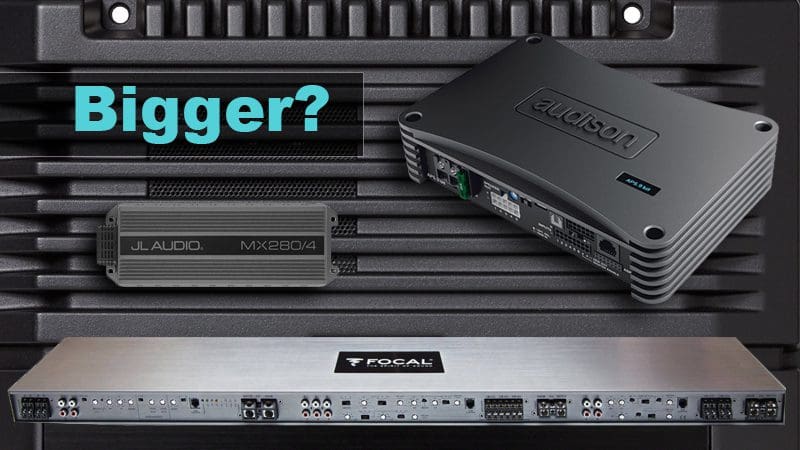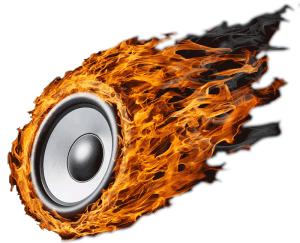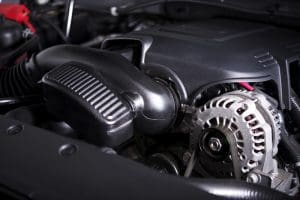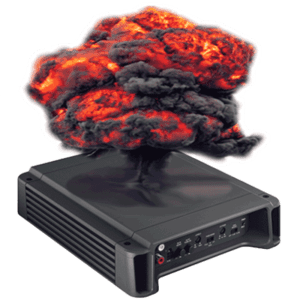 When an audio enthusiast goes shopping for an amplifier, the question of “how much power do I need?” comes up almost every time. There are a few factors to take into consideration when answering this question. This article looks at those factors and provides some technical background to help support your decision.
When an audio enthusiast goes shopping for an amplifier, the question of “how much power do I need?” comes up almost every time. There are a few factors to take into consideration when answering this question. This article looks at those factors and provides some technical background to help support your decision.
Why Do We Need Power?
 Quite simply, when you send more power to a speaker, it moves farther and produces more output. Two limiting factors within the speaker itself control how much power it can handle. At higher frequencies, the limit is heat. Speakers are notoriously inefficient. The best convert about 2% of the energy sent to them into sound and the rest is converted to heat. When you send 60 watts of power to a speaker, most of that energy heats up the voice coil and the components around it. Eventually, those components will reach a temperature where they will fail. The speaker will usually stop working at this point, or shortly after.
Quite simply, when you send more power to a speaker, it moves farther and produces more output. Two limiting factors within the speaker itself control how much power it can handle. At higher frequencies, the limit is heat. Speakers are notoriously inefficient. The best convert about 2% of the energy sent to them into sound and the rest is converted to heat. When you send 60 watts of power to a speaker, most of that energy heats up the voice coil and the components around it. Eventually, those components will reach a temperature where they will fail. The speaker will usually stop working at this point, or shortly after.
The second limiting factor is how far the speaker can move. Inexpensive midrange speakers may be able to move back and forth about half an inch without creating massive distortion. Higher-end speakers have as much as twice as much cone excursion capability. (Speakers don’t sound the same at high volumes as they do at low. Audition your speakers at the volume you will be using them.)
Power vs. Output
Power works like this: When you double the power going to a speaker, the output increases by 3 dB. That is not a large amount. In fact, it is the smallest change in amplitude that is perceivable across the audible frequency range. (1 dB is the smallest perceivable change in amplitude where our hearing is most sensitive – 1 to 2 kHz).
Perceived volume is a different beast. An increase of 10 times the power sent to a speaker produces a doubling of perceived volume.
Speaker Efficiency
Another consideration in choosing an amplifier is the efficiency of your speakers. An inexpensive conventional midrange speaker may produce an average output of 91 dB when measured 1 meter away from the speaker cone and when driven with 1 watt of power. A high-quality speaker will likely be less efficient, but capable of playing over a wide range of frequencies. A measurement of 85 dB efficiency at the same distance and power level is not uncommon.
How Loud Do We Need it?
 A typical RMS sound pressure level for an orchestra, when you’re seated three or four rows back from the musicians, is around 100 dB. If we use our analogy of the 85 dB efficient speaker, we need 31.6 watts to get that speaker to play 100 dB. The problem is that this is the average power, not the peak power. Perhaps the performance crests at 110 dB? In that case, we need a peak power level of 316 watts. Just keep in mind that the speaker components are likely to melt if you keep this effort up for any significant amount of time.
A typical RMS sound pressure level for an orchestra, when you’re seated three or four rows back from the musicians, is around 100 dB. If we use our analogy of the 85 dB efficient speaker, we need 31.6 watts to get that speaker to play 100 dB. The problem is that this is the average power, not the peak power. Perhaps the performance crests at 110 dB? In that case, we need a peak power level of 316 watts. Just keep in mind that the speaker components are likely to melt if you keep this effort up for any significant amount of time.
We don’t suggest buying any speaker based on its efficiency. Criteria like linearity, lack of distortion, application limitations and frequency range are far more important. If you need it loud, buy more speakers, or larger speakers.
Distortion Happens
What happens if we run out of power in an amplifier? We get distortion. This distortion creates all sorts of high-frequency harmonic content. That increased high-frequency energy is what causes tweeters to fail. We need to choose an amplifier that will allow our speakers to play loudly enough without running out of power.
You are better off buying a 100 watt per channel amplifier and only using 50 watts than you are buying a 50 watt amplifier and occasionally causing it to distort. Remember, those 50 extra watts only result in an increase in output of 3 dB – assuming the speaker can handle it.
It Takes Power to Make Power
 A consideration that many people overlook is the ability to supply an amplifier with the power it needs to produce the power you want. Modern vehicles have electrical systems with reduced power production capabilities. Smaller alternators, smaller batteries and smaller wiring save weight. Reduced weight transforms into better fuel economy for the vehicle.
A consideration that many people overlook is the ability to supply an amplifier with the power it needs to produce the power you want. Modern vehicles have electrical systems with reduced power production capabilities. Smaller alternators, smaller batteries and smaller wiring save weight. Reduced weight transforms into better fuel economy for the vehicle.
As a general rule of thumb for power consumption calculations, you can assume that every 100 watts of power from an amplifier will require about 10 amps of current from your electrical system. Yes, some amplifiers are more efficient than others, but this serves as a good, quick guideline.
If you want to purchase a 650 watt amplifier to power your subwoofer, then your electrical system (battery and alternator) has to be able to provide it with about 65 amps of current. This power requirement is on top of what is required to run the vehicle. The computers, lights, ignition system, radio and heater all consume power as well. On a modern compact car, it would be no surprise if you only had 30 to 40 amps of power left over for an amplifier.
You can get away with a big amplifier – but you can’t play it indefinitely, even with the vehicle running. Once you have exceeded the power delivery capabilities of the amplifier, the battery will start to supply current. You can kill a car battery, even with the vehicle running. Once you shut the car off, you may not have enough energy in the battery to restart it.
Blowing up Amplifiers
 Amplifiers do not like to be starved for power. When you run out of power to drive your amplifier, in most cases, the amplifier rail voltage starts to drop. Power starvation causes the maximum undistorted power production of the amplifier to decrease. We are back to the same scenario: Distortion causes harmonics, and harmonics can damage fragile speakers.
Amplifiers do not like to be starved for power. When you run out of power to drive your amplifier, in most cases, the amplifier rail voltage starts to drop. Power starvation causes the maximum undistorted power production of the amplifier to decrease. We are back to the same scenario: Distortion causes harmonics, and harmonics can damage fragile speakers.
If you have had an amplifier fail, and the failure was because the power supply section of the amp self-destructed, chances are you were not able to feed the amp properly.
How Much Amplifier Power Do You Need?
The solution: Buy as much as power as you can afford. Buy the biggest that will physically fit in your application. Get the highest-performance amplifier you can. Make sure your installer uses properly sized wiring to install the amplifier. Upgrade your car battery to a high-performance, high-capacity unit if you need more reserve power.
For more information, visit your local mobile electronics specialist retailer. Be honest about your needs and expectations for your audio system. They will be able to suggest a solution that sounds fantastic and will offer years of reliable performance.

I want to upgrade my stereo for a 2003 Harley flhtcu Electra glide.so many marine stereos from Sony are either out of stock or discontinued. I just purchased a Sony mex-72BT.
This has a55 watt peak amplifier built in., looking at either kicker or Fosgate 100 watt speakers 6.5 inch for fairing and 5.25 inch for rear seat. Will this set up give decent sound going down the highway or do I need to buy an add on amplifier.
The stereos with 100 watts peak all seemed to be sold out,that’s why I bought this stereo.
I also wanted CD capability because I like to listen to full albums and pandora
The solution offered in this article is opposite what I thought the article was advising us to do. The section immediately before the ‘solution’ talks about how equipment can get damaged if you don’t have enough power capacity in your system to support your amps/speakers, and the dangers of dropping rail voltage. Then the conclusion is to buy the largest, most power-hungry amp you can afford? Definitely the opposite of what I gathered from reading the article. I know personally that each amplifier-upgrade I do has multiple considerations that go into it: is my main power/ground wire big enough? How about my batterys RC and AH, got some room to spare there? Alternator, OEM comes with 160, if half goes to the vehicle from that is my new amp going to be able to thrive with less than 80amps available, plus whatever extra i have from the aftermarket batteries? I don’t think ‘buying the biggest I can afford’ would ever make sense in my decision-making timeline.